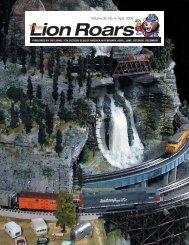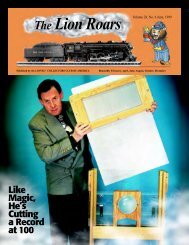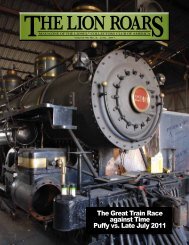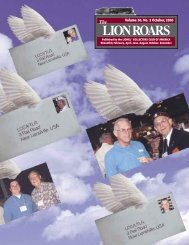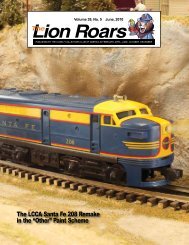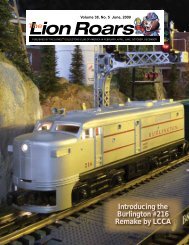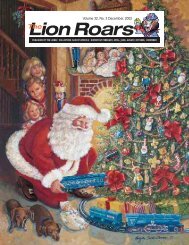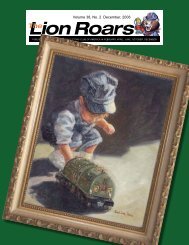Feb 2001 - Lionel Collectors Club of America
Feb 2001 - Lionel Collectors Club of America
Feb 2001 - Lionel Collectors Club of America
- No tags were found...
Create successful ePaper yourself
Turn your PDF publications into a flip-book with our unique Google optimized e-Paper software.
The TimplateCannonballby Ken Morgan RM 12231For this 100th anniversary year <strong>of</strong> our favoritemanufacturer <strong>of</strong> toy trains, I’d like to ask a little triviaquestion. What was the average wage in the U.S. in 1900?When you get to the answer below, remember what I justsaid about our subject: toy trains by <strong>Lionel</strong> — not investmentgrade collectibles. You’re on your own if you want to treateither current or previous production as anything other thantoy trains. My philosophy has always been that they havewheels; they’re supposed to roll down the tracks. There areno mint-in-the-box collectibles in my collection.Anyhow, in order not to favor any part <strong>of</strong> the century,I’ve focused this installment on the middle <strong>of</strong> the <strong>Lionel</strong>Century. Let’s look at one <strong>of</strong> the early die-cast steamers,and what happened to it just before and after WWII.The 225, with or without an “E” (it always came withthe reverse unit; the “E” discriminator was being phased outby <strong>Lionel</strong>), was part <strong>of</strong> <strong>Lionel</strong>’s major upgrade to the steamloco line in the middle 1930s. Sure, the 700E/763E gets most<strong>of</strong> the press, and I have already expressed my opinion thatthe 226 casting was one <strong>of</strong> the most important and goodlookingones <strong>Lionel</strong> ever made, even though thecontemporary 225 and 224 castings addressed other parts <strong>of</strong>the market. If the scale and semi-scale Hudsons pushed thepeak <strong>of</strong> <strong>Lionel</strong>’s potential market and the 226 was the highend <strong>of</strong> the major market, then the 225 was just one step below.Still near the upper end <strong>of</strong> the mass market as an O-gaugeloco, but a tad less expensive. It’s a little smaller than the226, and the tenders are smaller and cheaper than the big2226 which accompanied the 226. Like the 226, the castingwas only used for O gauge. The 224 — the next step down— had both multiple O-gauge and O27-gauge versions withdifferent numbers and motors. More on those some othertime.Introduced in 1938, <strong>Lionel</strong> catalogued the 225 for fiveyears through 1942. It came in several variations. The wheelconfiguration was 2-6-2, making it a Prairie type. It was<strong>of</strong>fered in either gunmetal gray or black. The gray versionhad either a six-1/8-inch number 2225 tinplate waffle toptender (the same as on the 265 Commodore Vanderbilt), or avery nicely detailed die-cast, eight-inch long 2235 tender.This tender is similar to the 2226 in its level <strong>of</strong> applied trim,but shorter and with four-wheel trucks. This version is fairlyhard to find. The 225 in black came with any one <strong>of</strong> threedifferent tenders:• The 2235 described above• A 2245, which is essentially the same except for thecoupler height — which makes it compatible withdifferent rolling stock• The cheaper plastic version <strong>of</strong> the 2235, which is a halfinchshorter and doesn’t have all the applied detailedtrim such as steps and some <strong>of</strong> the handrails.In accordance with1 <strong>Lionel</strong>’s practice at thetime, 225s wereavailable either with orwithout whistle. Thewhistle generally addedabout $1 to the cost, anda “W” suffix to thetender number. Photo 1has the 2225, 2245, andplastic 2235 top tobottom.The 225 had nicely modeled Baldwin disc drivers withsteel rims and well-detailed drive rods, plus threaded handrailstanchions, bell, and steam whistle. It is not hard to find indecent condition, and it has a high quality, smooth-runningmotor. It was usually catalogued with the small 2650 serieseight-wheeled freights, but also with the large 2800 seriesand even the “scale-detailed” 2900 freights, plus a variety<strong>of</strong> varnish, usually the 2600 series, but including even the2623 Manhattan cars, so it <strong>of</strong>fers lots <strong>of</strong> operating flexibility.<strong>Lionel</strong>, like just about everybody else, went into adifferent line <strong>of</strong> business from 1942 through ’45, but theywere looking forward to the return to a peacetime economyin 1946 and the introduction <strong>of</strong> new technology. Among thenotable developments were the knuckle coupler and locosmoke, both <strong>of</strong> which debuted with the 1946 line. But in’46, production was just starting up and reality almostrequired that existing tooling be reused as much as possibleto get products to the marketplace. At the same time, therewas a need to upgrade as much as possible to modernize<strong>of</strong>ferings.In 1946 <strong>Lionel</strong> catalogued a limited line, but 1947brought out a much longer roster. The 225, like many otherrelatively new castings, was modified for that year. Appearingas both the 675 (O gauge) and 2025 (O27), the originalcasting was altered to make it a bit more realistic and to bearmore resemblance to a prototype. <strong>Lionel</strong> changed the castingto represent a Belpaire firebox, which was typical <strong>of</strong> the PRRand a few other railroads. But PRR was probably the major8The Lion Roars <strong>Feb</strong>ruary, <strong>2001</strong>



